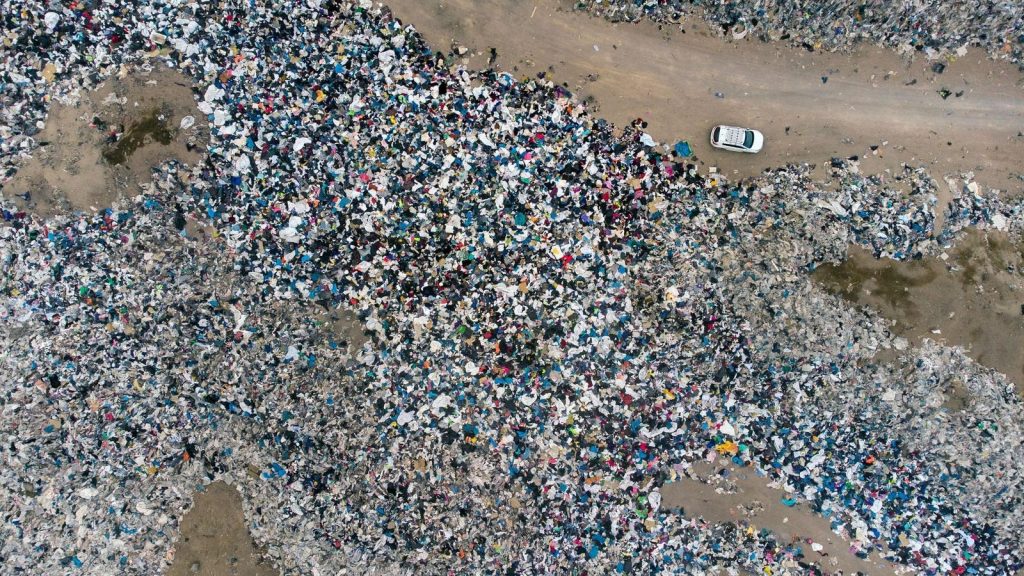This is the fourth article in the ongoing series exploring the intersection of fashion and sustainability—a journey that has uncovered the hidden emissions, toxic water pollution, and microplastic fallout sewn into the seams of what we wear. In this installment, we continue our focus on fashion’s waste crisis—one so vast that its impact is now visible from space. What happens to that waste is rarely shown on runways or in advertising campaigns? It piles up in deserts like Chile’s Atacama, where mounds of unsold garments—many still tagged—create sprawling landfills of fast fashion excess. It floods markets in West Africa, where secondhand donations, disguised as charity, arrive by the millions each week—only to overwhelm local waste systems, pollute beaches, and burn in open pits. This article exposes the underbelly of global fashion’s waste pipeline—from overproduction in the Global North to under-regulated dumping grounds in the Global South. It examines the systemic failures that allow this cycle to continue unchecked, and challenges the industry to move beyond lip service toward real responsibility, repair, and reform.
Fashion Waste: Landfills We Can See From Space
According to the Ellen MacArthur Foundation, the world produces over 92 million tons of textile waste annually, equivalent to a truckload dumped every second. According to Glimpse From The Global, vast quantities of unsold and discarded clothing are now littering desert landscapes, forming what many have dubbed “the great fashion garbage patch.” Towering mounds of textiles sprawl across the terrain, with some garments—price tags still intact—entangled among plastic bags, bottles, and other waste. According to recent estimates, as much as 39,000 tons of unwanted clothing are dumped in the end up annually in Chile’s Atacama Desert—visible from space—and that figure continues to grow.
Textile waste is often made of synthetic materials like polyester, which can take 20 to 200 years to break down, according to Business Waste statistics. These dumps not only scar the landscape, but also release toxic dyes, microplastics, and methane into the air and soil, worsening climate change and polluting nearby communities
Secondhand Fashion: Dumping in Disguise
Although donation is marketed as a noble gesture, according to Greenpeace, Germany alone collects roughly 1 million tons of used clothing each year—a figure that has surged by 20% since the mid-1990s, fueled by the relentless pace of fast fashion. Yet only a fraction of these garments are resold within the countries where they’re collected. In the UK, for instance, just 10–30% of donated clothing is resold domestically, with similar patterns observed in the U.S. and Canada.
The majority of second-hand clothes are shipped overseas, feeding into a vast global trade. Take the UK-based charity Oxfam: of the 11,000 tons of clothing it receives annually, only 27% is sold through its local shops. The rest is either discarded or exported—primarily to Eastern Europe and parts of East and West Africa. It’s estimated that over 70% of reused clothing from the UK alone ends up abroad, joining the billions of second-hand garments exchanged in the global resale economy each year. The rest are shipped to countries like Ghana, Kenya, and Uganda, where, up to 40% are too damaged to wear and end up in informal landfills, beaches or are burned. Ghana alone receives 15 million garments per week, overwhelming local waste systems and half of this amount is unsellable.
From Waste To Responsibility — The Way Forward For Fashion
The evidence is undeniable: pollution due to fashion is no longer hidden. It is floating in oceans, poisoning rivers, and piling up in deserts visible from space. According to the Ellen MacArthur Foundation and the UN, fashion is among the world’s highest-polluting industries—yet it remains one of the least regulated. Dr. Hakan Karaosman, chief scientist of Fashion’s Responsible Supply Chain Hub, powerfully argues, sustainability must go beyond green marketing and material choices. It must become embedded across the full spectrum of operations—from fiber to final stitch—grounded in science, ethics, and justice. His research underscores that true progress lies in transparent, inclusive supply chains that not only reduce emissions but also protect people and ecosystems.
The way forward requires bold shifts at every level.
1. Brands must move from performative sustainability to systemic accountability—investing in cleaner technologies, circular design, and the communities they source from.
2. Governments must implement policies that hold producers responsible for waste, emissions, and labor practices—both at home and abroad.
3. Consumers, empowered with knowledge, must demand better—not just for aesthetics, but for equity and environmental survival.
In the next article in this series, our attention will shift to labor, spotlighting the millions of workers—from fast fashion hubs to luxury ateliers in—whose low wages and unsafe conditions are quietly fueling the environmental crises in their own countries. Many brands may tout eco collections and possess sustainability certifications, but they remain silent on investments in waste infrastructure, water treatment, or environmental resilience in the very places where they profit most.
For further details, here are the other articles in the series:
- Beyond The Price Tag: The Dark Side Of Fast Fashion Business Models
- Beyond The Price Tag: The Dark Side Of Luxury And Circular Fashion
- The Hidden Crisis Of Fashion: Climate, Water & Microplastic Impact
Read the full article here









